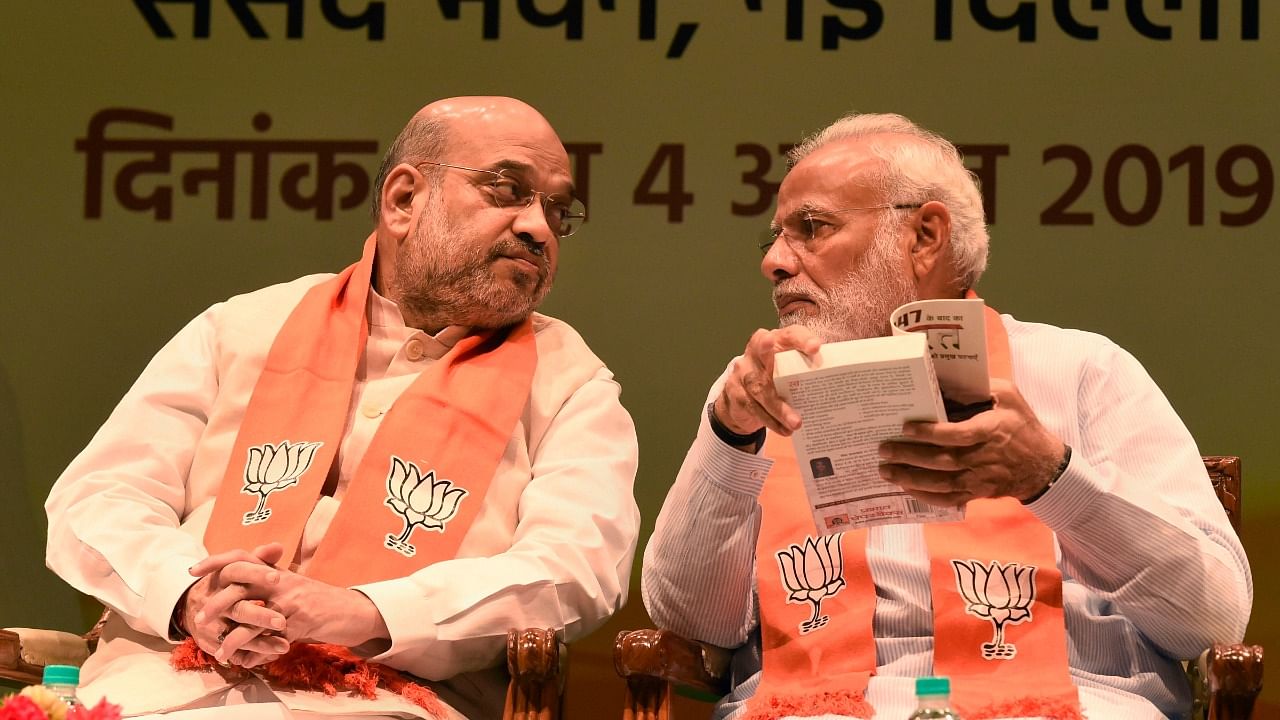
With the exit of the Janata Dal (United) from the National Democratic Alliance (NDA), the Bharatiya Janata Party (BJP) has lost another of its oldest friends.
The Shiromani Akali Dal, the Shiv Sena and the JD(U)'s earlier avatar, the Samta Party, had stood with the BJP even during the years the Hindutva party was considered a political pariah. All three have severed ties with the BJP since the 2019 Lok Sabha polls, and when it is at the height of its electoral sway. The BJP's tensions with another of its crucial southern allies, the Edappadi K Palaniswami-led AIADMK, have surfaced lately.
Former allies, like the Akalis, complained that the BJP had forgotten 'gathbandhan dharma', a process of regular consultations that the BJP's top leaders had with their allies, which kept the NDA vibrant. But of late, particularly after the split in the Sena, the fear among smaller allies is existential. Their leadership believes the BJP could usurp or split their parties, or they risk losing their respective support bases by aligning with the BJP.
Also Read | Nitish Kumar splits with ally BJP for second time, stakes claim as CM of Mahagathbandhan
The process of some of its key constituents exiting the NDA began in March 2018. With a year to go for the Lok Sabha and Andhra Pradesh polls, the Telugu Desam Party quit the NDA. With 16 MPs, the TDP was the third biggest party within the NDA at the time. While parting ways with the BJP couldn't help the TDP in the polls, its exit was a precursor to more such departures. While the BJP remains a marginal presence in Andhra, its influence in neighbouring Telangana has increased.
During the 10 years of the Congress-led UPA rule at the Centre, the NDA went through a difficult phase. The Mamata Banerjee-led Trinamool Congress and the Biju Janata Dal quit the alliance. Even in those trying years, the Akalis in Punjab, the Shiv Sena in Maharashtra and the JD(U) kept faith with the BJP. The JD(U)'s earlier avatar, the Samta Party and BJP, first allied for the 1996 Lok Sabha polls. The alliance benefitted both, with their coalition running the government from 2005 to 2013 in Bihar before Nitish Kumar quit the NDA that year. In the 2014 Lok Sabha, Kumar-led JD(U) performed poorly. The JD(U) returned to the NDA fold in 2017.
The attrition in the NDA has accelerated after the BJP's 2019 Lok Sabha triumph. The BJP has celebrated the anniversaries of its 2014 victory and forming its first-ever majority government at the Centre since 2015. However, the BJP no longer marks the anniversary of the formal launch of the NDA on May 15, 1998.
Also Read | Chirag Paswan slams Nitish Kumar for insulting people's mandate twice, seeks fresh polls in Bihar
The NDA went into the 2019 Lok Sabha polls as a 21-member alliance. By November, BJP's ally of over three decades, the Shiv Sena, parted ways. It complained the BJP, after the Maharashtra Assembly polls, reneged on its promise of sharing the CM's post. The two had first allied with each other in 1989. The BJP remained Sena's junior partner in Maharashtra until 2014, when it contested the Assembly polls on its own to score twice the Sena's wins.
When the Centre pushed for the farm laws, the Shiromani Akali Dal, another of the BJP's oldest allies, quit the NDA in September 2020. It helped neither, as the AAP decimated them in Punjab in March 2022. The two could come together in the run-up to the 2024 Lok Sabha.
The NDA has lost constituents earlier, some of which rejoined it later, like the All Jharkhand Students Union (AJSU). In Haryana, the BJP fell short of the majority mark and struck a post-poll alliance with the Jannayak Janata Party to form its government. Other parties to quit the NDA after 2019 are West Bengal's Gorkha Janmukti Morcha, Goa Forward Party (GFP) and Rajasthan-based Rashtriya Loktantrik Party.
The question is can the BJP do without allies? The BJP's win in Assam in 2021 was not possible without the help of its partners – the Asom Gana Parishad and United People's Party Liberal (UPPL). In Puducherry polls the same year, the BJP could not have won six of the nine seats it contested without support from its senior partner in the union territory, the All India N.R. Congress.
In the 2017 Assembly polls in Manipur, the Congress party emerged as the single largest party with 28-seats in a 60-member Assembly. However, the BJP, with 21-seats, formed the government with the help of the Naga People's Front (NPF), National Peoples Party (NPP) and LJP. Five years hence, in 2022, the BJP dispended with its allies and contested all 60 seats, winning 32. The BJP's former allies, NPF and NPP, did reasonably, but the BJP had a majority of its own.
The Goa story is somewhat similar. In the 2017 polls, Congress was the single largest party with 17-seats in the 40-member Assembly. But the BJP, with 13-seats, formed the government with the help of the GFP, Maharashtrawadi Gomantak Party and independents. In 2022, the BJP poached sitting legislators from the Congress, severed ties with its allies to contest all 40 seats, and formed the government.
The message from the BJP for its smaller allies is unmistakable. The BJP will tolerate them in its non-traditional areas only till such time that it takes roots organisationally. Interestingly, Banerjee's TMC and Patnaik's BJD are rare parties that have continued to prosper after severing ties with the BJP. Can Uddhav Thackeray's Sena and Nitish Kumar's JD(U) do the same?